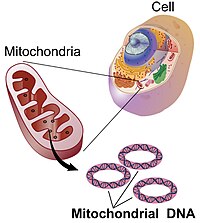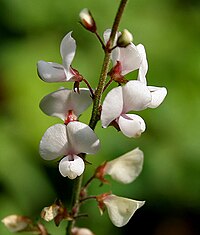
The complete plastid genome of Carmichaelia australis R. Br. (Leguminosae: Papilionoideae)
Sign Up to like & getrecommendations! Published in 2017 at "Conservation Genetics Resources"
DOI: 10.1007/s12686-017-0864-4
Abstract: The complete plastid genome of New Zealand endemic species Carmichaelia australis was assembled de novo from Next-Generation Sequencing data using CLC Genomics Workbench v.5.5. The plastome is 122,805 bp in length and lacks an inverted repeat… read more here.
Keywords: carmichaelia; genome carmichaelia; australis leguminosae; complete plastid ... See more keywords

Complete plastid genome of critically endangered plant Prangos trifida (Apiaceae: Apioideae)
Sign Up to like & getrecommendations! Published in 2017 at "Conservation Genetics Resources"
DOI: 10.1007/s12686-017-0945-4
Abstract: Prangos trifida (Mill.) Herrnst. et Heyn is a rare and critically endangered plant of Crimea. In this study, the complete sequence of the P. trifida chloroplast genome was determined using the NGS method. The complete… read more here.
Keywords: endangered plant; prangos trifida; critically endangered; complete plastid ... See more keywords

The Plastid Genome in Cladophorales Green Algae Is Encoded by Hairpin Chromosomes
Sign Up to like & getrecommendations! Published in 2017 at "Current Biology"
DOI: 10.1016/j.cub.2017.11.004
Abstract: Virtually all plastid (chloroplast) genomes are circular double-stranded DNA molecules, typically between 100 and 200 kb in size and encoding circa 80-250 genes. Exceptions to this universal plastid genome architecture are very few and include… read more here.
Keywords: dna; genome cladophorales; cladophorales green; plastid genome ... See more keywords

Complete plastid genome sequence of goosegrass (Eleusine indica) and comparison with other Poaceae.
Sign Up to like & getrecommendations! Published in 2017 at "Gene"
DOI: 10.1016/j.gene.2016.11.038
Abstract: Eleusine indica, also known as goosegrass, is a serious weed in at least 42 countries. In this paper we report the complete plastid genome sequence of goosegrass obtained by de novo assembly of paired-end and… read more here.
Keywords: genome sequence; goosegrass; eleusine indica; complete plastid ... See more keywords

Plastid genome data provide new insights into the phylogeny and evolution of the genus Epimedium
Sign Up to like & getrecommendations! Published in 2021 at "Journal of Advanced Research"
DOI: 10.1016/j.jare.2021.06.020
Abstract: Abstract Introduction Epimedium L., the largest herbaceous genus of Berberidaceae, is one of the most taxonomically difficult representatives. The classification and phylogenetic relationships within Epimedium are controversial and unresolved. Objectives For the first time, we… read more here.
Keywords: provide new; evolution; epimedium; genus ... See more keywords

The first plastid genome of a filamentous taxon ‘Bangia’ sp. OUCPT-01 in the Bangiales
Sign Up to like & getrecommendations! Published in 2018 at "Scientific Reports"
DOI: 10.1038/s41598-018-29083-5
Abstract: Red algae are important primary photosynthetic organisms. The Bangiales comprise a morphologically diverse order of red algae. Until now, complete plastid genomes of the Bangiales were only mapped for foliose species. To date, no filamentous… read more here.
Keywords: first plastid; filamentous taxon; genome filamentous; taxon bangia ... See more keywords

Reconfiguration of the plastid genome in Lamprocapnos spectabilis: IR boundary shifting, inversion, and intraspecific variation
Sign Up to like & getrecommendations! Published in 2018 at "Scientific Reports"
DOI: 10.1038/s41598-018-31938-w
Abstract: We generated a complete plastid genome (plastome) sequence for Lamprocapnos spectabilis, providing the first complete plastome from the subfamily Fumarioideae (Papaveraceae). The Lamprocapnos plastome shows large differences in size, structure, gene content, and substitution rates… read more here.
Keywords: plastome; lamprocapnos spectabilis; substitution rates; substitution ... See more keywords

A simple technology for plastid transformation with fragmented DNA.
Sign Up to like & getrecommendations! Published in 2022 at "Journal of experimental botany"
DOI: 10.1093/jxb/erac256
Abstract: Plastid engineering has several unique advantages such as high expression of transgene due to high polyploid of plastid genome and environmental biosafety because of maternal inheritance of transgene, and becomes a promising tool for molecular… read more here.
Keywords: plastid genome; dna; technology; plastid transformation ... See more keywords

Species discrimination in Schima (Theaceae): Next‐generation super‐barcodes meet evolutionary complexity
Sign Up to like & getrecommendations! Published in 2022 at "Molecular Ecology Resources"
DOI: 10.1111/1755-0998.13683
Abstract: Plastid genome and nuclear ribosomal DNA (nrDNA) arrays, proposed recently as “super‐barcodes,” might provide additional discriminatory power and overcome the limitations of traditional barcoding loci, yet super‐barcodes need to be tested for their effectiveness in… read more here.
Keywords: plastid genome; evolutionary complexity; nrdna arrays; species discrimination ... See more keywords

Comparative plastid genomics of four Pilea (Urticaceae) species: insight into interspecific plastid genome diversity in Pilea
Sign Up to like & getrecommendations! Published in 2021 at "BMC Plant Biology"
DOI: 10.1186/s12870-020-02793-7
Abstract: Background Pilea is a genus of perennial herbs from the family Urticaceae, and some species are used as courtyard ornamentals or for medicinal purposes. At present, there is no information about the plastid genome of… read more here.
Keywords: insight interspecific; urticaceae species; plastid; pilea ... See more keywords

Plastid genome evolution in tribe Desmodieae (Fabaceae: Papilionoideae)
Sign Up to like & getrecommendations! Published in 2019 at "PLoS ONE"
DOI: 10.1371/journal.pone.0218743
Abstract: Recent plastid genome (plastome) studies of legumes (family Fabaceae) have shown that this family has undergone multiple atypical plastome evolutions from each of the major clades. The tribe Desmodieae belongs to the Phaseoloids, an important… read more here.
Keywords: fabaceae; evolution; tribe desmodieae; plastid genome ... See more keywords